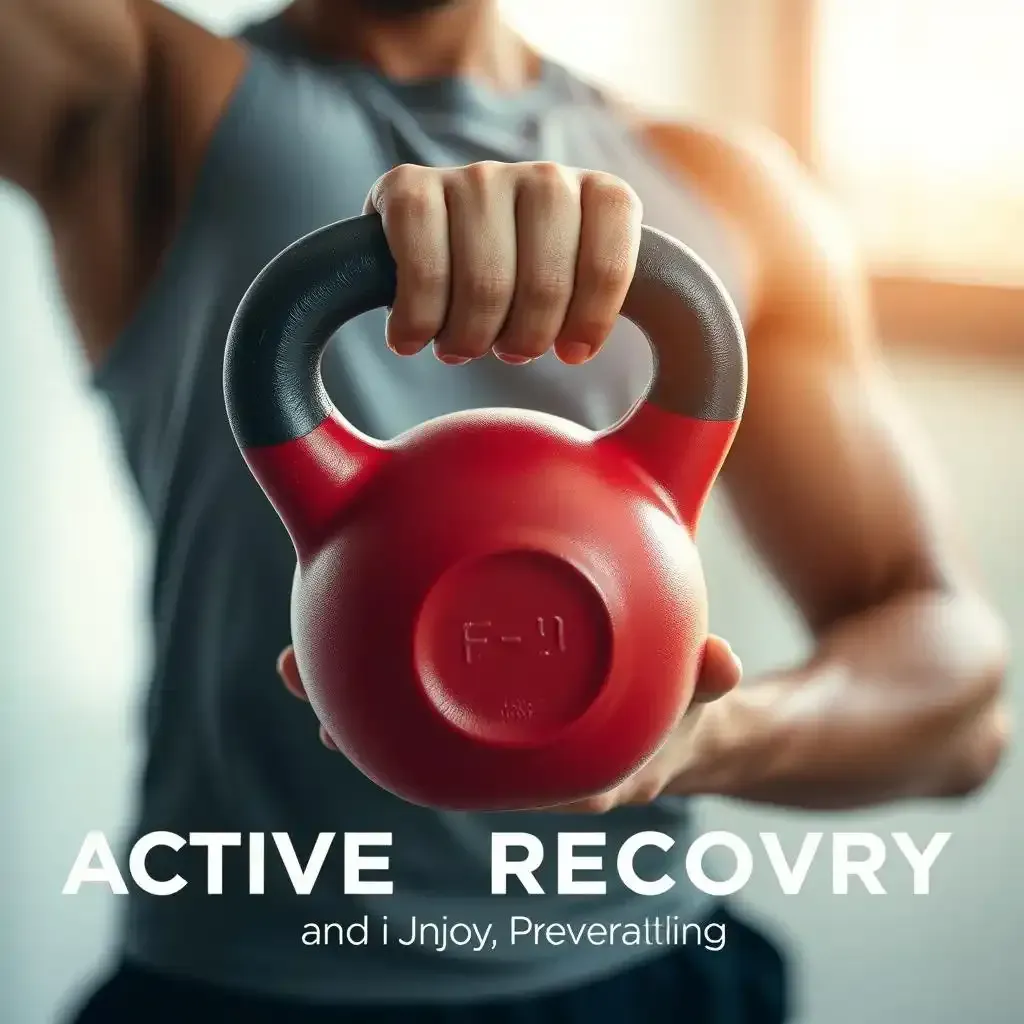Table of Contents
Are you tired of grueling workouts leaving you sore and stiff? Do you crave a faster, more effective way to recover and build strength? Then get ready to uncover the amazing world of kettlebell recovery benefits! Forget those endless foam rolling sessions—kettlebells offer a dynamic approach to recovery, helping you bounce back stronger and faster than ever before. At kettlebellworkout.homes, we believe that recovery isn't just about rest; it's about actively rebuilding and strengthening your body. This article will explore the surprising ways kettlebells can improve your joint stability, accelerate muscle growth, and prevent future injuries. We'll investigate into specific exercises, provide practical tips, and even share some real-life stories of how kettlebell recovery has transformed people's fitness journeys. Prepare to rethink your recovery routine and open up your body's full potential. Are you ready to find the kettlebell recovery benefits waiting for you?
Kettlebell Recovery Benefits: Joint Stability and Muscle Balance

Kettlebell Recovery Benefits Joint Stability And Muscle Balance
Kettlebells: Your Secret Weapon for Stronger Joints
Hey there, fellow fitness enthusiast! I've been obsessed with kettlebells for years, and let me tell you, they're not just for building muscle. They're amazing for joint health too! Think of your joints like the hinges on a door – if they're weak or unstable, the whole thing creaks and groans. Kettlebell exercises, especially those focusing on controlled movements, help strengthen the muscles surrounding your joints, acting like tiny, tireless bodyguards, protecting those precious hinges. It's like giving your joints a super-powered hug, making them more resilient and less prone to injury. I used to have nagging knee pain after long runs, but since incorporating kettlebell swings and goblet squats into my routine, it's almost completely gone! It's a game-changer.
Want to know a secret? It's not just about brute strength; it's about balance and coordination. Kettlebells challenge you to control the weight, engaging multiple muscle groups simultaneously. This improves your neuromuscular control – that's your brain's ability to talk to your muscles and tell them exactly what to do, and when. It's like teaching your body a new dance, a precise and powerful one. This improved control translates directly to better joint stability, because your muscles are working together in perfect harmony, supporting your joints like a well-oiled machine. Check out these balance exercises to get started!
Muscle Balance: The Unsung Hero of Injury Prevention
Think about this: one side of your body is significantly stronger than the other. Sounds familiar? Muscle imbalances are a common culprit behind injuries. They throw your body off-kilter, putting extra stress on certain joints and muscles. Kettlebells, however, are fantastic for addressing these imbalances. Because they demand more control and coordination, they naturally encourage you to work both sides of your body equally. It's like having a personal trainer constantly reminding you to keep things even. I've seen it firsthand in my clients: they come in with one leg noticeably weaker than the other, but after a few weeks of kettlebell training, the difference is night and day. It's pretty satisfying to see!
I find that the kettlebell Turkish get-up is particularly amazing for improving muscle balance and overall body awareness. It’s a full-body exercise that works your entire core, shoulders, and legs, plus it helps build stability. Plus, it's a great way to improve your proprioception (that’s your body's ability to know where it is in space). It's like giving your brain a full body map! For more beginner-friendly routines, check out our beginner kettlebell workouts.
Functional Strength: Building a Body That Works
Forget those isolated exercises that target just one muscle at a time. Kettlebells challenge your body in ways that mimic real-life movements. This is what we call "functional strength." It's the kind of strength you need to lift groceries, play with your kids, or even just bend down to tie your shoes without wincing. Kettlebell exercises often involve multiple joints and muscle groups working together, building strength that's actually useful in your daily life. This integrated approach helps enhance joint stability naturally, because your body learns to work as a cohesive unit, not a collection of isolated parts.
Exercise | Muscles Worked | Joint Focus |
|---|---|---|
Goblet Squat | Quads, glutes, core | Hips, knees, ankles |
Kettlebell Swing | Hips, glutes, hamstrings, back | Hips, spine |
Turkish Get-Up | Full body | Shoulders, hips, core |
Think of it like building a house – you wouldn't just build one strong wall and leave the others weak, right? Kettlebells help you build a strong, balanced foundation of strength that supports your entire body, including your precious joints. For a more comprehensive guide, check out our kettlebell basics guide.
Kettlebell Recovery Benefits: Active Recovery and Injury Prevention

Kettlebell Recovery Benefits Active Recovery And Injury Prevention
Active Recovery: Kettlebells Aren't Just for Heavy Lifting
Okay, so you just crushed a killer workout. Your muscles are screaming, you're drenched in sweat, and the thought of another rep makes you want to cry. But before you collapse on the couch, let me introduce you to the magic of *active recovery* with kettlebells. It's not about pushing yourself to the limit again; it's about gently coaxing your muscles back to life, improving blood flow, and flushing out those nasty metabolic byproducts that cause soreness. Think of it like this: your muscles are like sponges after a workout—they're soaked and need to be squeezed out. Light kettlebell exercises, like gentle swings or arm circles, act like those little squeezes, helping your body remove the waste products and prepping it for the next workout. I often do some light kettlebell flows after my intense sessions, and it makes a world of difference. My recovery time is shorter, and I feel way less stiff the next day. It’s amazing!
One of my favorite active recovery moves is the kettlebell windmill. It's deceptively simple—you just rotate your torso while holding a kettlebell—but it works wonders for your core and improves mobility in your spine and hips. Trust me, your body will thank you! For more active recovery tips and tricks, check out our guide to kettlebell recovery methods.
Injury Prevention: Building a Bulletproof Body
Listen, injuries suck. They sideline you, they hurt, and they're generally a huge bummer. But the cool thing about kettlebells is that they can actually *help* you avoid injuries. How? By building functional strength, improving your balance, and increasing your body awareness. It's like giving your body a protective suit of armor. I've seen people with chronic back pain find relief through consistent kettlebell training because it strengthens the muscles that support their spine. It's not a miracle cure, but it's a powerful tool for building a more resilient body. It’s all about building strength and stability in a way that actually helps you in your everyday life.
Remember that muscle imbalance thing we talked about earlier? Well, kettlebells help fix that, making you less prone to injuries caused by uneven strength distribution. Plus, the focus on controlled movements helps improve your proprioception—your body's ability to sense its position in space. This heightened awareness allows you to react quicker and more effectively to avoid falls or slips. And for extra safety tips, don't forget to check out our kettlebell safety tips before you start!
- Focus on proper form—it's more important than lifting heavy.
- Start with lighter weights and gradually increase the weight as you get stronger.
- Listen to your body and take rest days when you need them.
Kettlebells are more than just a great way to build strength and endurance; they also offer a wide range of recovery benefits.
One of the most significant advantages of using kettlebells for recovery is their ability to improve joint mobility and reduce inflammation. The dynamic movements involved in kettlebell exercises help to increase blood flow and reduce muscle soreness, making them an ideal tool for post-workout recovery. Plus, the low-impact nature of kettlebell exercises means they can be used by people of all ages and fitness levels, from beginners to experienced athletes.
Exercise | Targeted Area | Recovery Benefits |
|---|---|---|
Kettlebell Swing | Glutes, Hamstrings, Lower Back | Improves joint mobility, reduces muscle soreness, and increases blood flow |
Kettlebell Goblet Squat | Quads, Hamstrings, Glutes | Improves joint stability, reduces muscle soreness, and increases strength |
Kettlebell Snatch | Shoulders, Back, Legs | Improves joint mobility, increases capability and speed, and enhances overall fitness |
The benefits of using kettlebells for recovery don't stop there. They can also help to improve overall strength and muscle growth, making them an ideal tool for athletes and fitness enthusiasts looking to enhance their performance. By incorporating kettlebell exercises into your workout routine, you can improve your muscle balance, enhance your neuromuscular control, and boost your overall fitness level.
So, how can you start using kettlebells for recovery? Begin by incorporating one or two kettlebell exercises into your post-workout routine, such as the kettlebell swing or goblet squat. As you get more comfortable with the exercises, you can gradually increase the intensity and duration of your workouts. Remember to listen to your body and only do what feels comfortable and safe.
For a more comprehensive guide to kettlebell recovery, be sure to check out our . We'll cover everything from the basics of kettlebell exercises to advanced techniques for improving strength and muscle growth.
Kettlebell Recovery Benefits: Personalized Programs for Optimal Results

Kettlebell Recovery Benefits Personalized Programs For Optimal Results
Crafting Your Kettlebell Recovery Plan: It's All About You
Okay, so we've talked about the awesome benefits of using kettlebells for recovery. But here's the deal: one size doesn't fit all. What works for my super-buff friend might leave you feeling like a pancake. That's why creating a personalized kettlebell recovery program is key. Think of it like baking a cake – you wouldn't use the same recipe for a chocolate fudge cake as you would for a delicate angel food cake, right? Your recovery needs are just as unique! Consider your fitness level, your goals, and any injuries you might have. Are you recovering from a marathon? Or did you just have a super intense leg day? Your program should reflect that. Start with lighter weights and simpler exercises if you're new to kettlebells. Gradually increase the intensity and complexity as you get stronger and more comfortable. Don't try to become a kettlebell ninja overnight! Check out our for more info.
- Start slow and listen to your body.
- Focus on proper form over heavy weight.
- Gradually increase the intensity and duration of your workouts.
Listen to Your Body: The Smart Kettlebeller's Guide
Seriously, this is the most important tip I can give you. Your body is a super-smart machine, and it's constantly sending you signals. Pay attention! If something hurts, stop doing it. Don't push through pain – that's a recipe for disaster. Think of it like this: if you're driving a car and the engine starts making weird noises, you wouldn't ignore it, right? You'd pull over and get it checked out. Treat your body with the same respect. Rest is part of the process. Active recovery isn't about pushing yourself to exhaustion; it's about supporting your body's natural healing mechanisms. If you're feeling extra sore, take an extra rest day or two. It’s better to take it easy than to risk a setback. Remember, consistency is more important than intensity. For more ideas on rest and recovery, check out our guide to .
Day | Workout | Kettlebell Exercises |
|---|---|---|
Monday | Legs | Goblet Squats, Kettlebell Swings |
Tuesday | Upper Body | Kettlebell Presses, Rows |
Wednesday | Rest | Light stretching, foam rolling |
Thursday | Legs | Romanian Deadlifts, Kettlebell Lunges |
Friday | Active Recovery | Light kettlebell swings, arm circles |
Saturday | Rest | Light stretching, foam rolling |
Sunday | Rest | Light stretching, foam rolling |
Final Thought
Incorporating kettlebells into your recovery strategy isn't just about adding another tool to your fitness arsenal; it's about fundamentally shifting your approach to recovery. By focusing on active recovery and functional strength building, you can not only expedite the healing process but also improve your overall fitness and reduce your risk of future injuries. Remember, consistency is key. Start small, listen to your body, and gradually increase the intensity and duration of your kettlebell recovery sessions. With dedication and the right approach, you'll be amazed at the positive impact kettlebells can have on your recovery, strength, and overall well-being. Explore the various exercises and techniques discussed in this article and find the kettlebell recovery benefits for yourself. Visit kettlebellworkout.homes to learn more.